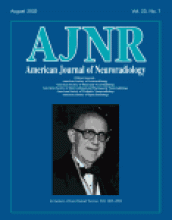Abstract
BACKGROUND AND PURPOSE: Patients with cerebrovascular occlusive disease may develop compensatory changes in local cerebral vasculature with a resultant loss of vascular reactivity. These alterations can affect the blood oxygen level-dependent (BOLD) signal that is the basis for functional MR imaging. We investigated the BOLD signal in patients with unilateral cerebrovascular disease to ascertain the clinical utility of functional MR imaging in these patients.
METHODS: Five healthy volunteers and three patients with cerebro-occlusive disease were imaged with both a block and an event-related design of a visually cued bilateral motor task. Activation maps were calculated, and individual hemodynamic response curves were generated for left and right primary motor cortices. Vascular reserve was determined for the relevant vascular territory by using transcranial Doppler ultrasonography (US).
RESULTS: In the event-related data, the amplitude of the BOLD response was significantly decreased in the motor cortex ipsilateral to the stenosis and showed significant delays in the timing of the hemodynamic response. In contrast, the longer duration stimulus and longer TR of the block design showed significant decreases in the BOLD amplitude but no significant interhemispheric temporal differences. Corroborating the hemodynamic status, transcranial Doppler US analysis showed diminished vascular reserve ipsilateral to the lesion.
CONCLUSION: Differences in the results between the event-related and block paradigms reflect the sensitivity to alterations in autoregulation or vascular compliance. These changes in the vasculature directly affect the BOLD contrast underlying functional MR imaging. Thus, while this technique remains a useful clinical tool, caution is warranted when studying patients with cerebrovascular disease.
- Copyright © American Society of Neuroradiology












